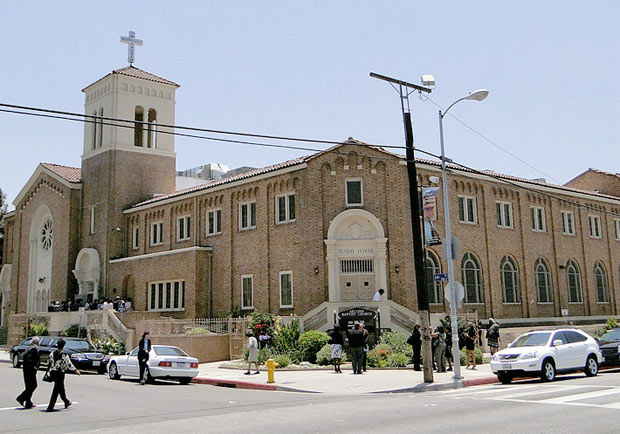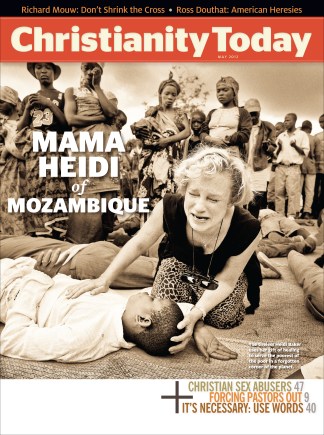Every week as he delivers the sermon at the oldest black church in Los Angeles, pastor William Eps stands where history was written. Martin Luther King Jr. spoke at Second Baptist Church throughout the 1950s and ’60s. Today social justice remains just as important to the 127-year-old church—but the faces of the community it serves have changed dramatically.
Decades ago, members of the predominantly black congregation lived nearby and walked to services. Today the church is a commuter congregation—its black members no longer live in the neighborhood, which, like the rest of once-black South Los Angeles, is now Latino.
Richard Flory, director of research at the University of Southern California’s Center for Religion and Civic Culture, said that while the city’s ethnic makeup has been changing since the 1990s, the newest manifestation is the identity shift of South Los Angeles churches from community churches to commuter churches.
Paul Felix, president of the Los Angeles Bible Training School, does not see black churches relocating in the same way that white churches relocated to the suburbs in the 1950s and ’60s.
“Financially, it is a challenge. [And] finding a central place to reach all of the congregants is difficult,” Felix said. “With the demographic change, you don’t have a predominantly African American community [in Los Angeles] anymore.”
Many black churches have declined in attendance; some now have just over a dozen worshipers, Flory said. “There is a point at which they have to create programs and services that draw [the neighborhood] in,” he said. “The church is a core part of the black community. I don’t know how that will work with other ethnic groups.”
Commuter members drive 30 minutes to an hour to attend the South Los Angeles churches where they once lived. But rising gas prices and scarce parking (many churches were built when members only walked to services) have caused many to relocate to churches closer to their current homes, said Mark Whitlock, senior minister of Christ Our Redeemer AME Church in Irvine. He was responsible for community development at First AME Church in South Los Angeles for 15 years, and saw the shift firsthand.
“It’s not the first time there has been a demographic shift in Los Angeles, but it has clearly devastated some houses of worship,” Whitlock said.
Historically, black churches have always had an active role in their communities, but today face the challenge of serving a community that has a different culture, worship style, and language.
“Churches are not serving the community they’re located in; [they] are emptying and becoming museums of past ministries,” Whitlock said. “God never intended for us to divide—there is no Asian, black, white, or Latino heaven. We have to move away from ethnocentric places of worship.”
Bethel University sociology professor Samuel Zalanga said it is important for Christians to understand social and economic changes.
“Churches are impacted beyond their control,” he said. “There is a need to understand society. Christians cannot assume they’re immune to economic changes.”
Juan Martinez, associate provost for diversity at Fuller Theological Seminary, said churches growing in Southern California today have a significant Latino presence, while those not growing do not.
Thus the changing demographic can be a massive opportunity for revitalization for struggling churches in decline, said Martinez. “Be attentive to what [God] is doing in the neighborhoods, and be serious about building bridges to what Los Angeles is becoming.”
Black churches have responded to the demographic change in a variety of ways, notes Martinez. Some churches have relocated to the suburbs; others have chosen to build bridges to the Latino community by hiring a bilingual pastor; and others have redefined their mission to stay and serve their new community.
Second Baptist commissioned a neighborhood study by the University of Southern California in order to determine how to serve its Latino neighbors better. It now runs a childcare program for 140 Latino children and owns and operates 110 housing units. Seventy percent of residents are Latino.
“It reflects the community,” Eps said. “Given the demographic … we will probably become a multiethnic congregation.”
Copyright © 2012 Christianity Today. Click for reprint information.
Related Elsewhere:
Previous Christianity Today coverage of the growth of the Latino church in the U.S. includes:
A Spanish Service Is Not Enough: It’s Time to Feed the ‘Hellenized Latinos’ | Spanish-speaking ministry models are designed to preserve the preferences of the foreign born. (January 19, 2012)
Will Immigration Slowdown Prompt a Bilingual Ministry Bust? | Churches retool Hispanic outreach after recession impact. (January 19, 2012)
Counting Controversy | Hispanic evangelical leaders debate participation in 2010 U.S. Census. (August 17, 2009)
The Soul of the Border Crisis | Local churches are key in fixing the immigration mess. (June 8, 2009)
Despite Protestant Growth, Hispanic Catholicism Holds Steady in U.S. | Younger generations leaving for Protestant churches, but immigrants make up difference. (February 1, 2003)
Church Growth: New Latino Congregations Spring Up | Church networks are cooperating to launch congregations in unlikely U.S. locations. (September 6, 1999)
CT also has more news stories.










